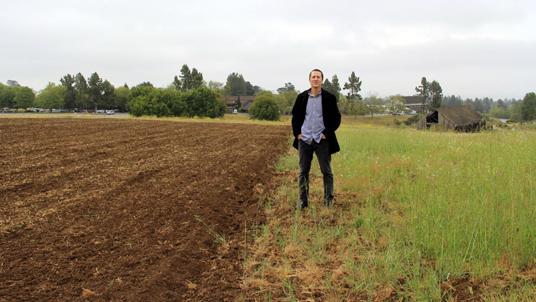Campus News
New 3-acre Hay Barn and 2-acre lower quarry fields added to UCSC Farm
A public tour is set for Saturday, June 29, of new fields added to the UCSC Farm. The tour, from 10 a.m. to noon, will include a visit to the soon-to-be restored historic Cowell Ranch Hay Barn.

Public tour set for Saturday, June 29
The UC Santa Cruz Farm sprouted a new fence line this spring. Looking west from Coolidge Drive, new deer fencing is visible surrounding the “Hay Barn” field, a three-acre addition to the Farm’s existing 25 acres. Combined with the “lower quarry” field, bordered by the bike path and Hagar Drive, the Center for Agroecology & Sustainable Food Systems (CASFS) is adding five new acres for organic farming, research, and training.
“Five acres may not sound like much, but that’s about a third again as much land as we are actively cultivating down on the Farm,“ said CASFS Executive Director Daniel Press. “This acreage will allow us to dedicate the existing fields for production while we try out new crops and research and teaching techniques on the new fields.”
Press will lead a tour of the new acreage Saturday, June 29, that will include a visit to the historic Cowell Ranch Hay Barn slated to be restored for use as offices, classrooms, and public meeting space. (See earlier story on the restoration here.) The tour will take place from 10 a.m. to noon and the public is invited. (Details below.)
Plans for the newly fenced Hay Barn field include growing crops for UCSC Dining Services to boost the supply of fresh produce available directly from the Farm to campus dining halls, said Darryl Wong, CASFS farm site and research lands manager.
New fields, new opportunities
The expanded acreage will also offer new opportunities for members of the CASFS Apprenticeship training course, who spend six months at UCSC learning organic farming and gardening skills.
“Growing larger blocks of crops than is now possible on existing farm fields will give our apprentices an opportunity to experience organic farming practices on a larger scale than what the farm currently offers,” Wong said.
The new fields also create more space for research by campus faculty and collaborators. According to Wong, because the Hay Barn field has not been actively cultivated before, it presents an opportunity to observe what happens to the soil as it is converted to an organic agroecosystem.
Research projects
Possible research projects include analyzing the weed seed bank for the types and amounts of weed seeds present, measuring changes to the amount of soil organic matter, and testing the ability of anaerobic soil bacteria to suppress pathogens, such as those that plague strawberries.
UCSC undergraduates will have the chance to be involved in both farming and research using the new fields. This spring, students in the Environmental Studies Agroecology Practicum class collected vegetation and insect samples in the Hay Barn field to establish baseline data before they were tilled. Wong envisions a series of courses and internships that will give students the chance to gain hands-on experience in crop planning and production.
The Hay Barn and Lower Quarry fields were annexed to the UCSC Farm about 10 years ago in exchange for land used by the Ranch View Terrace housing development.
A public tour of the UCSC Farm and the new Hay Barn field and Hay Barn restoration project is scheduled for Saturday, June 29. The public is invited to join CASFS Executive Director Daniel Press for strawberry shortcake starting at 10 a.m. at the Louise Cain Gatehouse on the UCSC Farm before touring the sites. Please RSVP by June 26 by calling (831) 459-3240 or by email to casfs@ucsc.edu.